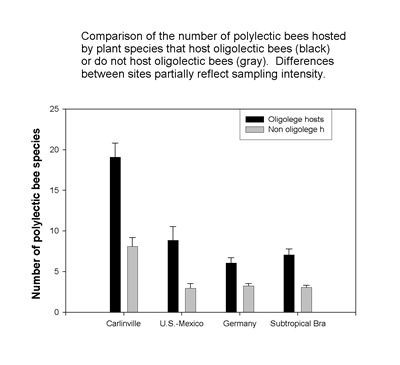
Robert L. Minckley
Professor of Instruction
PhD
Research Active
- Office Location
- 446 Hutchison
- Telephone
- (585) 275-0272
- Web Address
- Website
Office Hours: Tuesday 11:00-12:00PM; Thursday 11:00-12:00PM
Research Overview
Ecology and evolutionary advantages of pollen specialization in bees:
Many bee species collect pollen from one or a few plant host species even when other plants in the same community are also flowering. Why these specialist bee species do not use other plants remains an open question. At present, it is easier to rule out what does not explain host specificity in bees than it is to identify a single factor. Hypotheses not supported include: 1) that pollens contain secondary compounds that require physiological adaptations by the adult or larvae to properly digest them; 2) flower shapes or rewards are highly modified in ways that might deter visitation by generalist bee species; and, 3) pollens are unusually nutritious. Rather, many plant species that host specialist bees are unusually attractive to generalist bee species in the same community, have flowers that are open and seemingly easy to forage from, and produce abundant floral resources (nectar and pollen).
In an ongoing project with T’ai Roulston (University of Virginia) and Neal Williams (University of California-Davis), we are finding that most specialist bees in deserts visit those plants in a community most attractive to other generalist bee species. This pattern appears to be common to different parts of the world (see figure) and suggests that specialist bee species may often be unimportant pollinators of their host plants, and that coevolution in these plant-pollinator interactions is weak or nonexistent.
In a detailed study of one plant species (Larrea tridentata) that attracts 22 species of specialist bee species and more than 80 generalist bee species, we found the species richness and relative abundance of specialist bee over generalist bee species was greater where the plant bloom least frequently (Minckley et. al 2000). This counterintuitive pattern suggests that one advantage of specialization among bees is to minimize long-term variation in resource levels. We hypothesized that generalist bee species were extirpated from areas where L. tridentata bloomed least frequently because in some years they emerge and find little or no resources. In contrast, specialist bee bees remain in diapause in years when bloom on L. tridentata is poor (Minckley et al. 2000). If generally true for other bee species, this hypothesis suggests that pollen specialization in bees does not require nutritional or other foraging benefits to bees, or chemical coevolution between floral rewards and the pollinators they have evolved to attract.
Biodiversity and community structure of desert bees:
We have been sampling bees and recording flowering phenology of plants in permanent plots in the San Bernardino Valley Sonora/ Arizona since late-summer 2000. Sampling is done primarily using pan traps (http://online.sfsu.edu/~beeplot/), which have the advantage that sampling effort is not biased and attract floral visitors regardless of if plants at the site are in flower, but also by net at flowering flowers. Identification to the level of species of the more than 89,000 specimens is still in progress. However, based on 85,000 identified specimens from these collections taken from an area of 10-15 square miles have yielded approximately 500 bee species. The San Bernardino Valley rests at one of the major ecological crossroads of the world. To the east lies the Chihuahuan Desert, to the west is the Sonoran Desert, to the north is the temperate grasslands and Boreal forest, and to the south is the subtropics. The contribution of these source areas is probably an important reason underlying the high number of bee species found in this area.
Conservation biology of pollinators:
Habitat loss is adversely affecting species of many groups and pollinators are no different. Because they are intimately associated with reproduction of so many flowering plant species, pollinator species are thought to be keystone to ecosystem function; their population and species richness decline could have unusually widespread consequences to humans and ecosystem function. Information on pollinator populations in relatively undisturbed habitats is rare but suggests natural populations are highly variable over small to large spatial and temporal scales. Studies on pollinator loss and its effect on ecosystem function tend to be in agricultural systems that are already overexploited. Our long-term study in the San Bernardino Valley is therefore one of few studies that may provide a baseline that will help estimate the magnitude of seemingly drastic changes reported in bee populations and species richness of more highly modified ecosystems.
Research Interests
- Ecology and evolution of host breadth in bees
- Community structure of desert bees
- Conservation biology of pollinators
Selected Publications
- Williams, N.M., Crone, E.E., Roulston, T.H., Minckley, R.L., Packer, L. and S.G. Potts. 2010. Ecological and life history traits predict bee species responses to environmental disturbances. Biological Conservation. In Press.
- Droege, S., Tepedino, V., Griswold, T., LeBuhn, G., Link, W., R.L. Minckley and 3 others. 2009. North American Bee Bowl (Hymenoptera: Apiformes) Trap Evaluation 1: Spatial Patterns of Captures. Insect Conservation & Diversity.3: 15-23.
- Minckley, R.L. 2008. Faunal composition and species richness differences of bees (Hymenoptera: Apiformes) from two North American regions. Apidologie.39: 176-188.
- 2006. Incidental mutualisms and pollen specialization among bees. Plant-Pollinator Interactions: From Specialization to Generalization, Waser, N.M. and J. Ollerton (eds.). Univ. of Chicago Press. 69-98.
- 2006. Complex responses within a desert bee guild (Hymenoptera: Apiformes) to urban habitat fragmentationEcological Applications.16: 632-634.
- 2001. Variation in bee faunas and its implications for future studiesConservation Ecology.5: 7.
- 2000. Origins and ecological consequences of pollen specialization among desert bees. Proceedings of the Royal Society, London B.267: 1-7.

